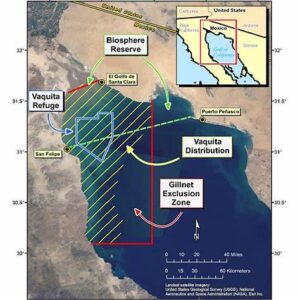Only 10 vaquitas (Phocoena sinus) — the world’s rarest marine mammal remain alive, according to a damning new report by the North American Environmental Commission (CEC). The tiny porpoise, endemic to the Upper Gulf of California is now perilously close to extinction.
The CEC an environmental body established under the United States-Mexico-Canada Agreement (USMCA) has squarely blamed the Mexican government for failing to enforce its own wildlife protection and trade laws failures that have allowed illegal fishing and wildlife trafficking to flourish in the vaquita’s last refuge.
Illegal Gillnets, Totoaba Trafficking at the Heart of Crisis
At the core of the vaquita decline is illegal gillnet fishing for totoaba a large fish whose swim bladder is highly prized in traditional Chinese medicine and can sell for thousands of dollars in East Asia.

Vaquitas are not targeted directly, but they become entangled in the gillnets used to catch totoaba and die as by-catch. Despite an official ban on such nets since 2020, fishing activities “continue at similar levels and with the same gear as before the restrictions, the report noted.
Eyewitness accounts and interviews conducted by NGOs and researchers confirmed that illegal fishing continues largely unabated in the vaquita’s habitat known as the “Zero Tolerance Area” of the Upper Gulf.
Enforcement Lags Far Behind Promises
The report accused Mexico of making promises on paper while failing to act in practice.
Under a Compliance Action Plan adopted through the convention on International Trade in Endangered Species of Wild Fauna and Flora (CITES) Mexico committed to:
•Expanding vessel inspections
•Installing satellite tracking devices on fishing boats
•Developing alternative fishing gear to replace deadly gillnets
Yet, as of June 2025, only 10 of the 850 promised satellite trackers had been fitted on small boats operating in the Upper Gulf, according to the Center for Biological Diversity, a U.S.-based nonprofit.
The report also found that fishermen routinely evade restrictions by transferring illegal catch to processors outside the protected area. “Mexico has failed to provide sufficient information, leaving central enforcement questions unanswered,” the Center said in its statement.
The Vaquita’s Last Refuge
U.S. Pressure Could Escalate Under USMCA
The CEC findings now open the door for the United States Trade Representative (USTR) to increase diplomatic and trade pressure on Mexico through the USMCA environmental enforcement mechanisms.
Experts are urging the U.S. government to use every tool available to hold Mexico accountable.
If Mexico does not take decisive action, the USTR could escalate the issue to a formal dispute panel, which would have the authority to impose import penalties or trade sanctions until Mexico fully enforces the gillnet ban in vaquita habitat.
A Global Conservation Symbol
Although the vaquita lives only in a small pocket of the Gulf of California, conservationists say the crisis symbolizes a broader global challenge:the intersection of wildlife crime, weak governance, and biodiversity loss.
Low-lying coastal and island communities around the world face similar environmental pressures from overfishing to habitat loss and rely on strong environmental enforcement to survive.
Hope Remains But Time Is Running Out
With just 10 vaquitas left in the wild, conservationists warn that the species is functionally extinct unless immediate and robust protection is enforced.
“The vaquita can still be saved,” the Center for Biological Diversity has emphasized in past statements, “but only if gillnets are removed from their habitat immediately and permanently.”
As the CEC’s report makes clear, the window for action is closing. The fate of the vaquita and the credibility of international environmental agreements now hinges on whether Mexico, and its North American partners, will act in time.
